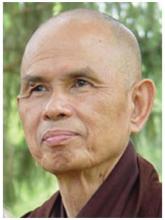

Counting one's breath and following one's breath
Counting one's breath and following one's breath
Thich Nhat Hanh
In the meditation sessions I recently began for non-Vietnamese, I usually suggest various methods that I myself have tried, methods that are quite simple. I suggest to beginners the method of "Following the length of the breath." The student lies, back down, on the floor. Then I invite all of the participants to gather around so I can show them a few simple points:
1) Although inhaling and exhaling are the work of the lungs, and take place in the chest area, the stomach area also plays a role. The stomach rises with the filling of the lungs. At the beginning of the breath the stomach begins to push out. But after inhaling about two-thirds of the breath, it starts to lower again.
2) Why? Between your chest and stomach there is a muscular membrane, the diaphragm. When you breathe in correctly the air fills the lower part of the lungs first, before the upper lungs fill with air, the diaphragm pushes down on the stomach, causing the stomach to rise. When you have filled your upper lungs with air, the chest pushes out and causes the stomach to lower again.
3) That is why, in former times, people spoke of the breath as originating at the navel and terminating at the nostrils.
... After several times, you will know the "length" of your breath: Perhaps it is 5. Now try to extend the exhalation for one more count (or 2) so that the exhalation's length becomes 6 or 7. Begin to exhale counting from 1 to 5: When you reach 5, rather than immediately inhaling as before, try to extend the exhalation to 6 or 7. This way you will empty your lungs of more air. When you have finished exhaling, pause for an instant to let your lungs take in fresh air on their own. Let them take in just as much air as they want without making' any effort. The inhalation will normally be "shorter" than the exhalation. Keep a steady count in your mind to measure the length of both. Practice several weeks like this, remaining mindful of all your exhalations and inhalations while lying down. (If you have a clock with a loud tick you can use it to help you keep track of the length of your inhalation and exhalation.) For beginners, lying down to practice breathing is very helpful. The important thing is to guard against making too much of an effort: too great an effort can be dangerous for the lungs, especially when the lungs are weak from many years of incorrect breathing. In the beginning, the practitioner should he on his or her back on a thin mat or blanket, the two arms loosely at the sides. Don't prop your head on a pillow. Focus your attention on your exhalation and watch how long it is. Measure it slowly by counting in your mind: 1, 2, 3,
Continue to measure your breath while walking, sitting, standing, and especially whenever you are outdoors. While walking, you might use your steps to measure your breath. After a month or so, the difference between the length of your exhalation and inhalation will lessen, gradually evening out until they are of equal measure. If the length of your exhalation is 6, the inhalation will also be 6.
If you feel at all tired while practicing, stop at once. But even if you do not feel tired, don't prolong the practice of long, equal breaths beyond short periods of time-l0 to 20 breaths are enough. The moment you feel the least fatigue, return your breathing to normal. Fatigue is an excellent mechanism of our bodies and the best advisor as to whether one should rest or continue.
Your breath should be light, even, and flowing, like a thin stream of water running through the sand. Your breath should be very quiet, so quiet that a person sitting next to you cannot hear it. Your breathing should flow gracefully, like a river, like a watersnake crossing the water, and not like a chain of rugged mountains or the gallop of a horse. To master our breath is to be in control of our bodies and minds. Each time we find ourselves dispersed and find it difficult to gain control of ourselves by different means, the method of watching the breath should always be used.
The instant you sit down to meditate, begin watching your breath. At first breathe normally, gradually letting your breathing slow down until it is quiet, even, and the lengths of the breaths are fairly long. From the moment you sit down to the moment your breathing has become deep and silent, be conscious of everything that is happening in yourself.
As the Buddhist Sutra of Mindfulness says:
"Breathing in a long breath, you know, 'I am breathing in a long breath.'
Breathing out a long breath, the practitioner knows, 'I am breathing out a long breath.'
Breathing in a short breath, you know, 'I am breathing in a short breath.'
Breathing out a short breath, you know, 'I am breathing out a short breath.' Experiencing the whole breath-body, I shall breathe in." Thus you train yourself. "Experiencing the whole breath-body, I shall breathe out." Thus you tram yourself. "Calming the activity of the breath-body, I shall breathe in." Thus you train yourself. "
Calming the activity of the breathbody, I shall breathe out." Thus you train ourself. "
After about 10 to 20 minutes, your thoughts will have quieted down like a pond on which not even a ripple stirs.
Do not miss :

